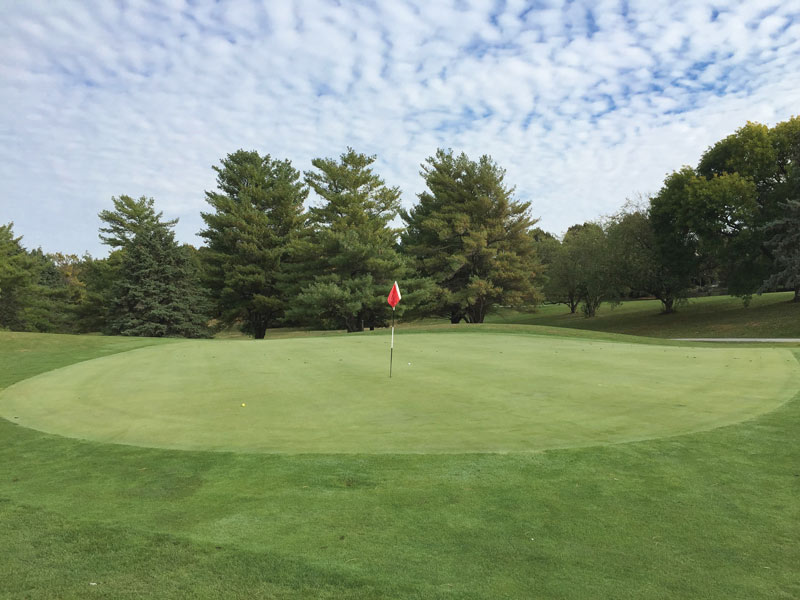
A better understanding of trees’ utility can help golf course superintendents produce a quality golf experience. Here, backdrop trees offer important depth clarity for the golfer. Photos by John C. Fech
It’s a common tendency to regard trees and shrubs as aesthetic features, but there’s much, much more to them than just their good looks. Sure, trees add color, texture, verticality, depth and appeal in all seasons, but there’s also a functional dimension to tree placement on a golf course.
Perhaps the best way to consider the functionality of a golf course tree is to ask yourself, “What is it there for?” Golf course architects can usually cite two or three reasons why a tree is placed in a certain location, and at least one will be how it functions.
Generally, there are 10 categories of functional uses for trees on golf courses:
- Trees that serve as backdrops for greens.
- Trees that help identify doglegs.
- Trees that screen undesirable views and reduce noise.
- Trees that are signature features.
- Trees that provide protection and safety separation.
- Trees that are obstacles/increase difficulty.
- Trees that are directional.
- Trees that provide shade for clubhouses/refreshment stands.
- Trees that help with framing.
- Habitat trees.
Editor’s note: Removing trees from your course? Dealing with tree damage or disease? GCM’s collection of “tree-sources” can help.
1. Trees as backdrops for greens
As approach shots in the fairway are lined up or tee shots on a par 3 are struck, a need exists for golfers to visualize the distance from their ball to the flag. Trees alongside and behind a green provide this special assistance. This benefit is manifested in terms of greater clarity regarding the difference in turfgrass height and color from fairway to green and the waving of the flag in the wind when viewed against the tree’s leaves, trunk and overall silhouette.
With regard to backdrop trees, the question often arises, “Just how close to the playing surface should the tree be located?” Considering the sensitivity of bentgrass and bermudagrass to increased levels of shade, the answer is: close enough to provide the benefit, but far enough away to minimize excessive shade stress on the putting surface, which can be a delicate balance, to say the least. The density of the tree canopy, debris droppage potential of the specimens, and the evergreen/deciduous nature of the species are all considerations in making species choices.
2. Trees that identify doglegs
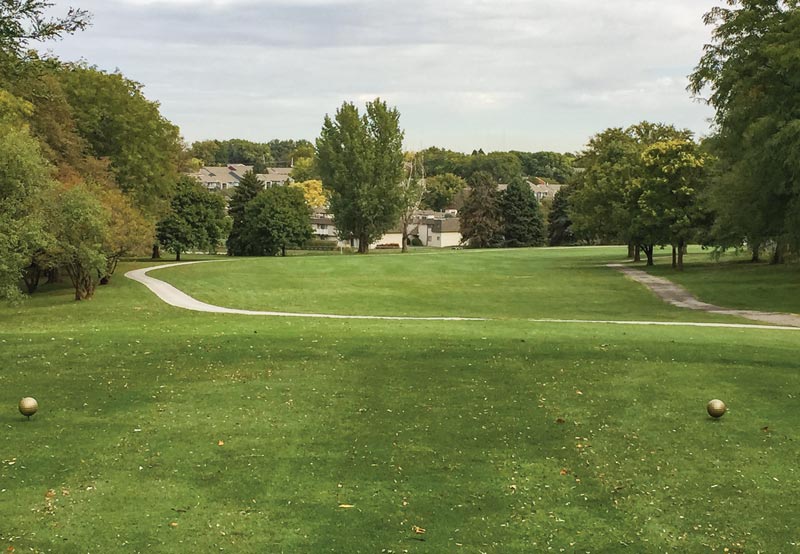
Greater awareness of the dogleg direction can be provided with a well-placed tree.
Trees placed to identify where the direction of a hole shifts from straight to curved are similar to backdrop trees, providing distance guidance, yet they add another dimension — a directional purpose. These trees provide the golfer with the added benefit of being able to identify whether a hole plays to the right or left, as well as a target zone, especially when a grouping or massing of trees is implemented. In fact, if the desire is for the dogleg to be strongly identified, a massing of trees is recommended. If the intent is for the benefit to be more subtle, single specimens are often used.
Common locations for dogleg trees to be placed include the beginning of the curve or angle in the layout and the opposite side of the fairway where the hole turns.
3. Screening trees
Screening trees can supply both functional and aesthetic benefits, especially coniferous species. A specimen with a thick, dense canopy will greatly reduce unwanted noise from busy roadways or manufacturing plants. While not all noise-producing entities are unattractive, many are, and the benefit of blocking undesirable views is certainly a bonus.
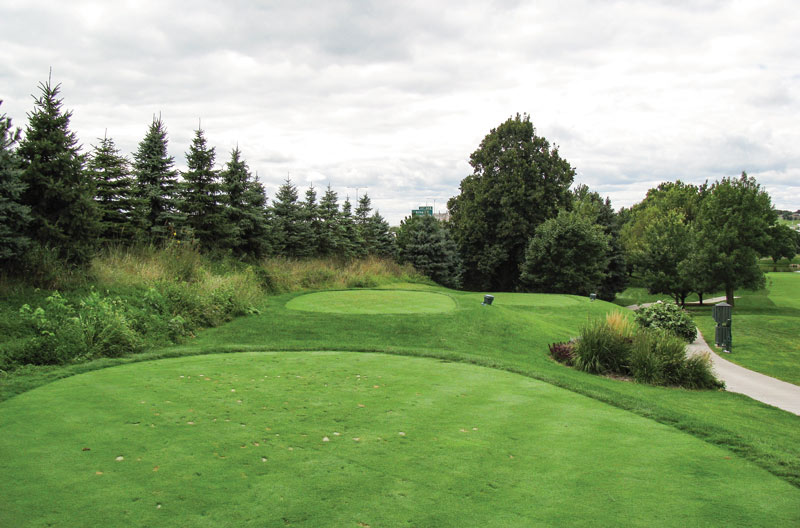
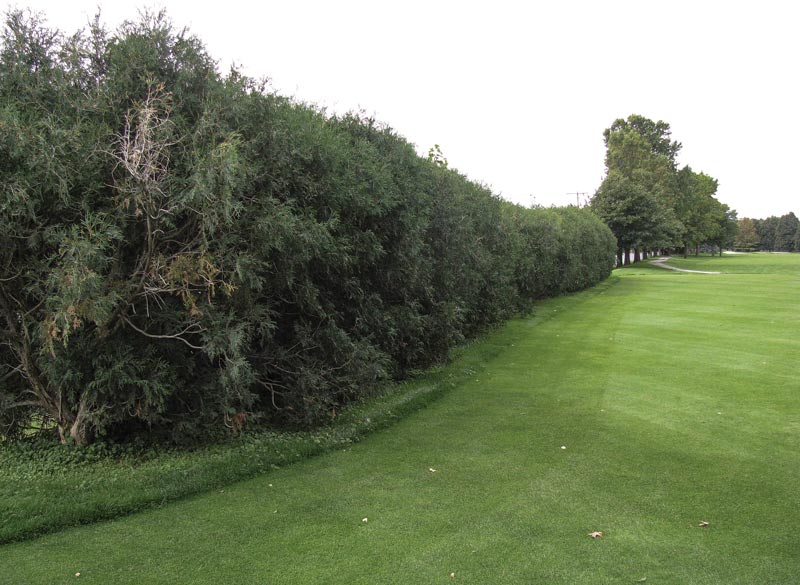
Well-established trees can conceal undesirable views and decrease noise.
Given that unattractive vistas such as factories and junkyards are present 365 days a year, the use of evergreens for this purpose is especially appropriate. When deciding upon plant spacing and placement, it’s helpful to take some cues from the foresters who design windbreaks for farmsteads. The general recommendations include at least two rows of trees, spaced 20 to 25 feet apart, with individual specimens located 15 to 20 feet apart in the rows, depending on the expected height and width of the species. Woody plants can also be used to screen less-than-appealing aspects of the golf course itself, such as pump houses and restrooms.
4. Signature trees
A person’s signature is unique — a special scratching out of their name, as only they can do. In some scenarios, a signature tree is appropriate for a golf course. Sometimes, history calls for it if a certain tree was notable when the course was being built or was designated for continuance after a renovation. In other situations, it may be more reputational or symbolic, such as when the name of a tree species is in the name of a course, such as Quarry Oaks or Sycamore Hills. Of course, in these cases, at least a few trees of that species are expected to be in the tree inventory.
A common location for these trees is at the entrance road or the clubhouse, where the association can be easily noted. Signature trees can also simply be an element of the course that makes a statement — a stunning piece of the golfscape.
5. Trees for protection
Some courses are laid out with great distances between where shots are struck and where they can possibly land, and some are not. For the latter, the “tighter” layouts, protection trees are especially important.
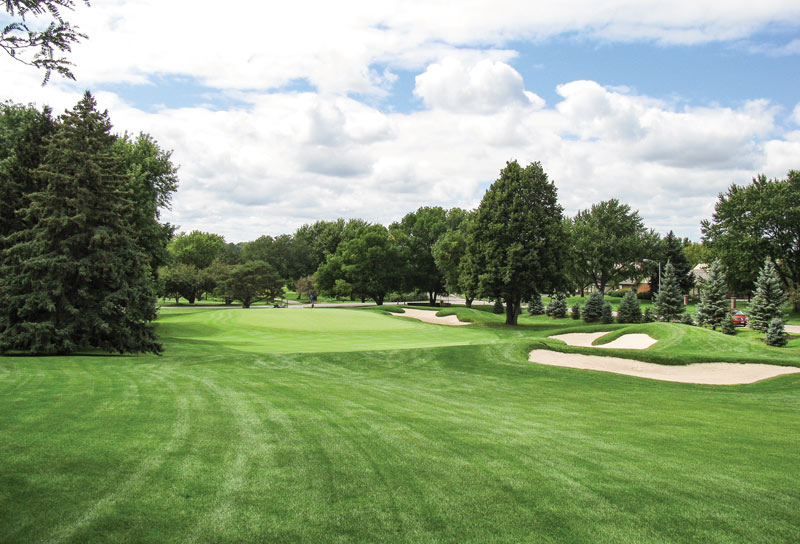
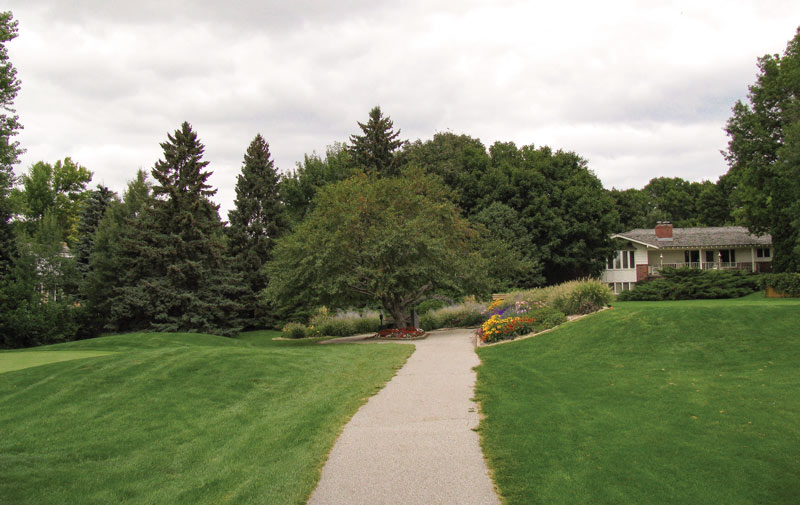
The risk of errant golf balls striking unsuspecting people can be greatly diminished via good tree placement.
Often planted between adjacent fairways and between tees and nearby non-golf properties, these specimens serve to prevent balls from striking otherwise preoccupied people. Common examples include trees that protect residential properties, swimming pools, parks and hotels. Installation of trees for this purpose provides greatly reduced liability and a degree of safety separation for a golf course. As with screening trees, a dense canopy usually helps to provide maximum benefit.
6 and 7. Obstacle and directional trees
A certain degree of difficulty is inherent in all golf holes, the exact nature of which greatly depends on the type of course and can vary widely across a continuum of sites — practice facilities, municipal courses, public daily-fee and membership-exclusive clubs. In the hands and mind of a savvy golf course architect, a well-placed tree can produce an appropriately challenging obstacle as golfers line up an approach shot or strive to keep a drive in the fairway. Whenever a modification of direction is desired — some subtle, others more overt — the two main factors involved are the size/shape of the tree species and the placement in the rough.
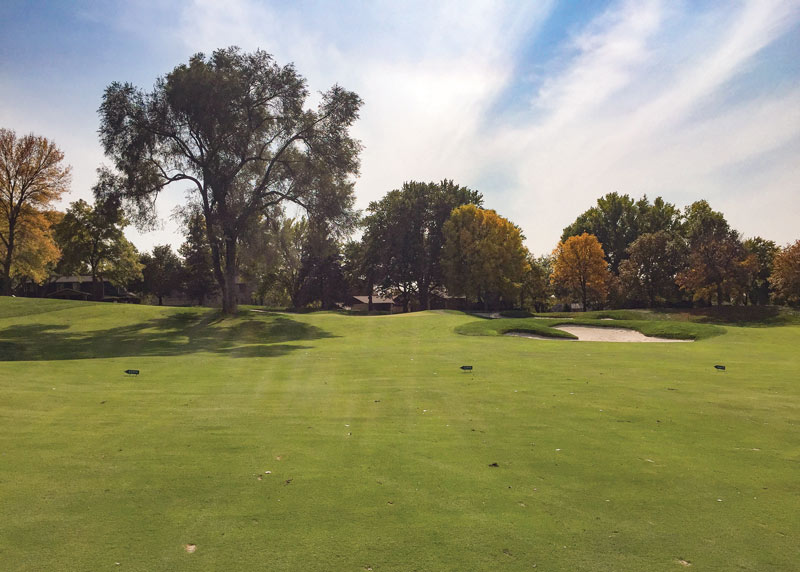
Strategic tree placement can increase or decrease a hole’s degree of difficulty.
Because obstacle and directional trees are by default in close proximity to golfers, it’s crucial that they be regularly inspected by an arborist certified by the International Society of Arboriculture (ISA) for safety, stability and overall health.
Editor’s note: Looking for outside help managing and maintaining the trees on your golf course? Intent on tackling the task in-house? See Tree care: In good company for points to consider, including information on ISA-certified arborists.
8. Shade trees
One of the most basic tree functions is shade, especially for non-turf areas such as clubhouses, outdoor dining areas, refreshment stands and restroom facilities. The temperature reduction and glare relief provided in these locations are great benefits and should not be taken lightly.

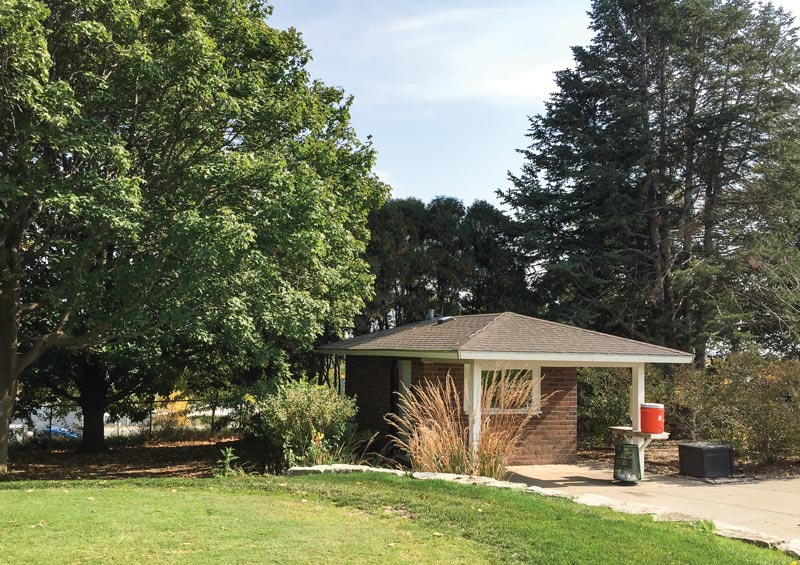
A reprieve from the sun can be welcome during a round of golf, and what better to furnish it than a stately tree?
Of course, if shade is excessive, and it often is, it is important to be intentional about the density of the canopy of the chosen tree species and to implement a regular tree-removal plan as light intensity decreases over time. Regular monitoring of photosynthetically active radiation (PAR) will provide useful management information. It can also be helpful to use shade-tolerant turf species in these locations, such as centipedegrass, St. Augustinegrass, or fine or tall fescues.
9. Framing trees
Family portraits and great works of art usually have a substantial frame surrounding them. Depending on the nature of various golf course features, it may be appropriate to incorporate framing trees at these locations as well.
Specifically, clubhouses, reception facilities and welcome areas often benefit from the special definition provided by framing trees. A common framing arrangement is the placement of large specimens of the same species on both sides of the feature that is to be emphasized. If the need to draw attention to a particular element is greater, more trees can be used in an effort to frame the space, as in a portrait.
10. Habitat trees
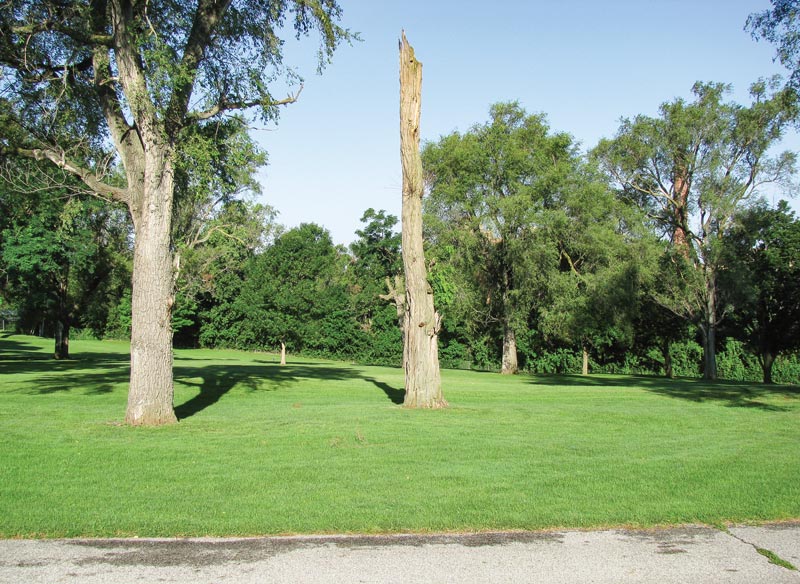
If they pose no threat of striking a golfer or valuable piece of property, consider leaving some dead trees standing to benefit birds.
Perhaps the most benevolent of all tree functions are trees that have been allowed to remain on a course for many years after they have died. Even though these specimens have ceased to provide much in the way of shade, screening, protection, shot clarity or aesthetic appeal, they still have value as habitat trees. Throughout the year, various species of raptors and songbirds can use such trees for perching and harborage as well as or better than they can use more desirable varieties.
The key to using habitat trees is to be certain of their stability and to locate them where they do not detract from the overall aesthetic appeal of the course. As mentioned earlier, consultation with an ISA-certified arborist is important for these and other trees on the course. Experienced and well-trained tree professionals will be certain to provide guidance as to the likelihood of a tree striking a person or valuable piece of property.
Final evaluations
As you ponder each of these purposes, consider that some trees will serve several functions and others just one or two. And, as you reevaluate the status of other features or pests or problems on the course, it just makes sense to give a second thought to the purpose of the trees nearby.
Whether it’s done hole by hole or randomly, it creates valuable insights that can be used in many proactive ways, including avoiding the removal of trees that provide invaluable benefits and bolstering the defense of your retain-or-remove decisions to various golf course stakeholders.
John C. Fech is a horticulturist and Extension educator with the University of Nebraska-Lincoln. He is a frequent and award-winning contributor to GCM.